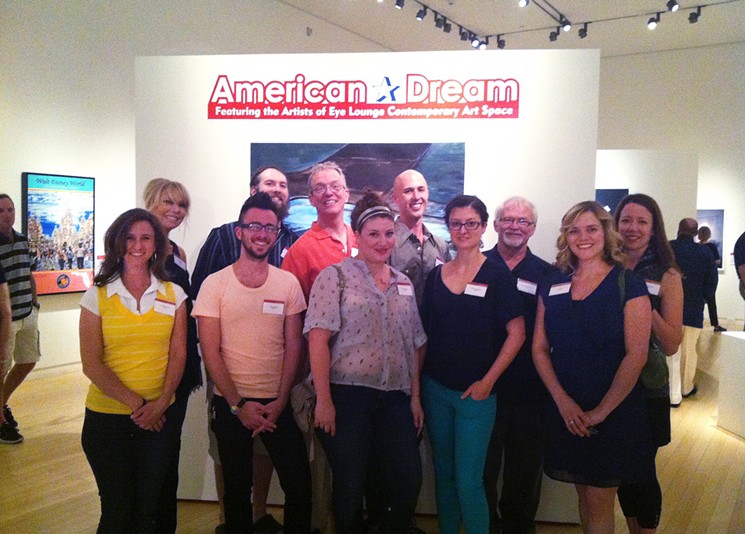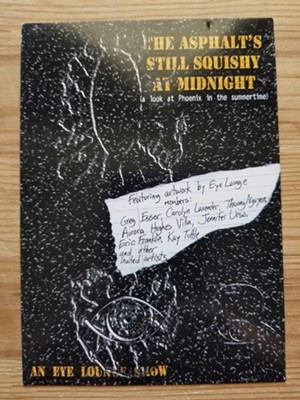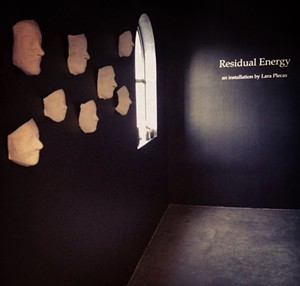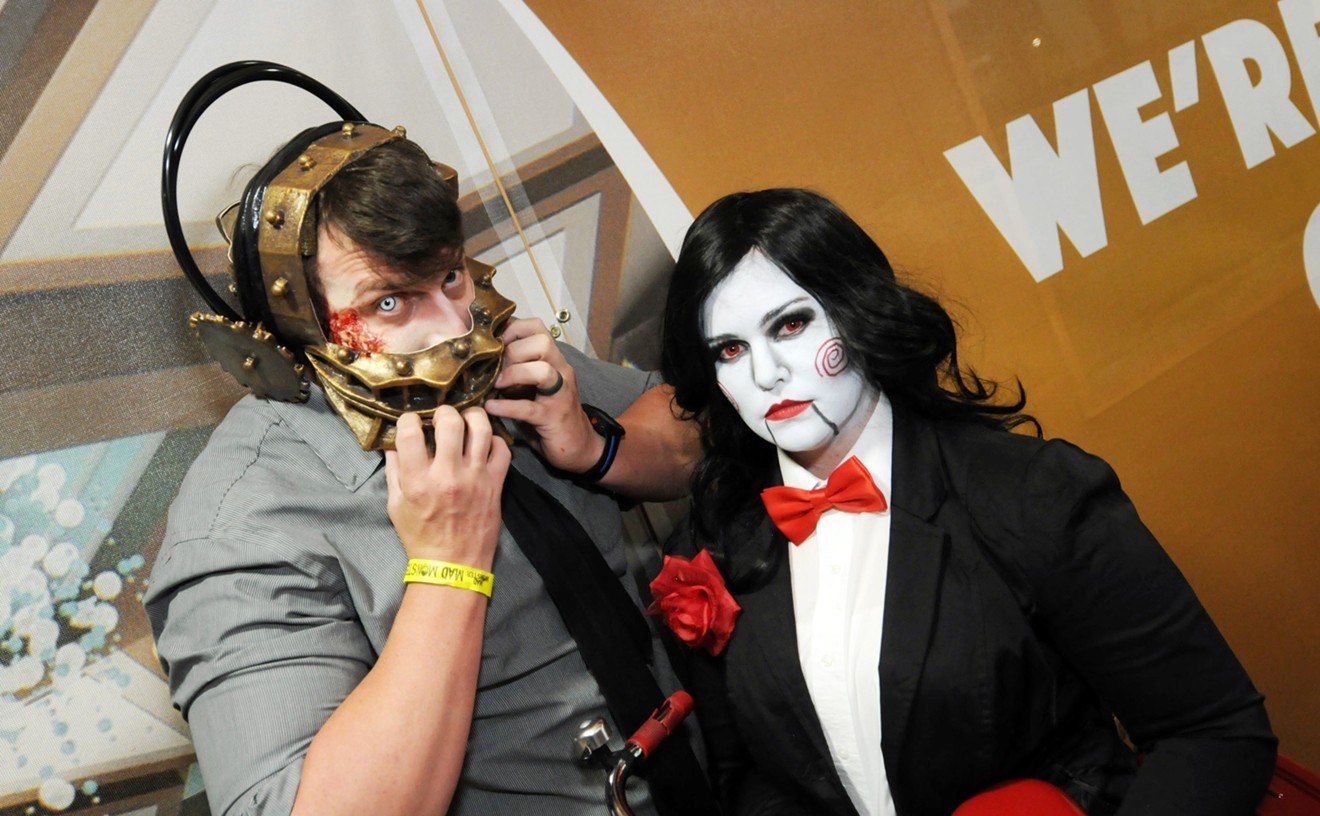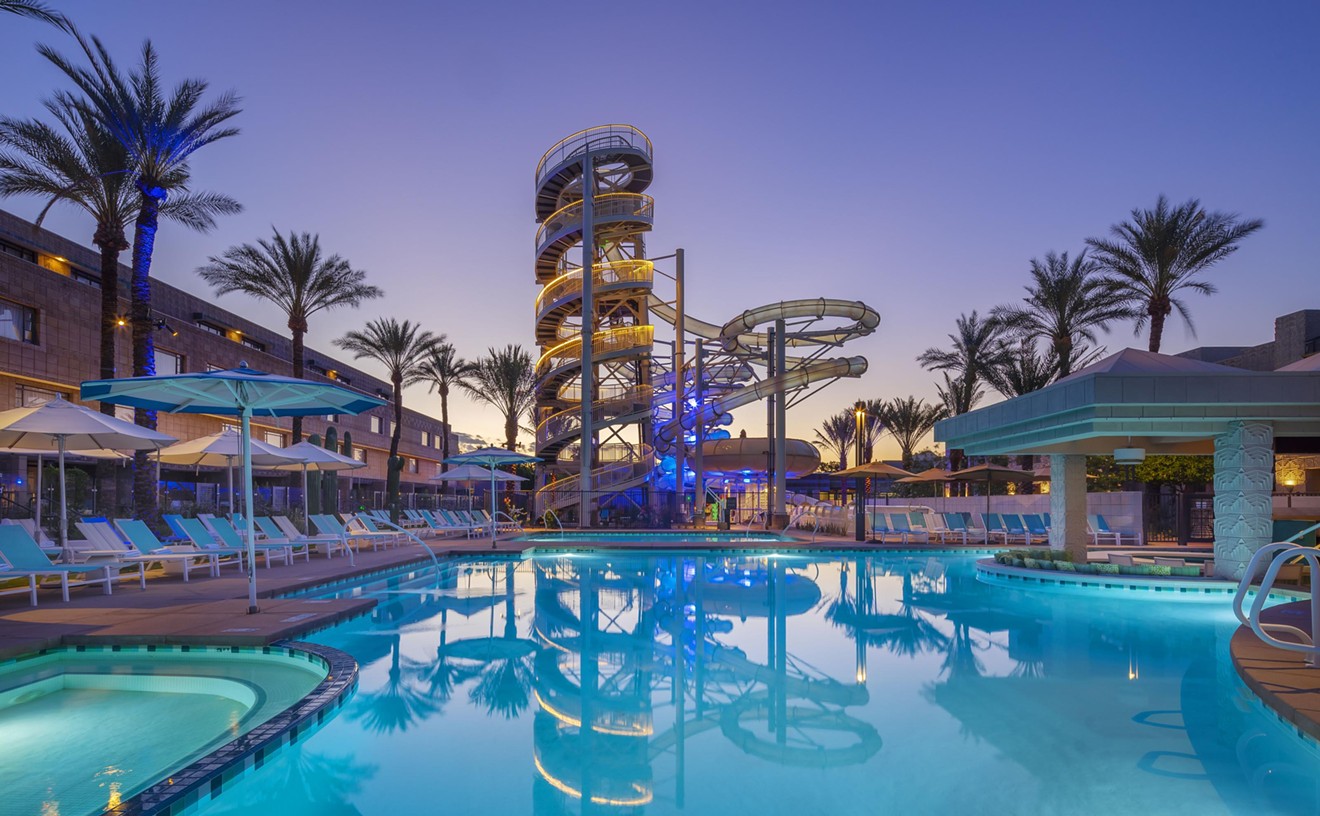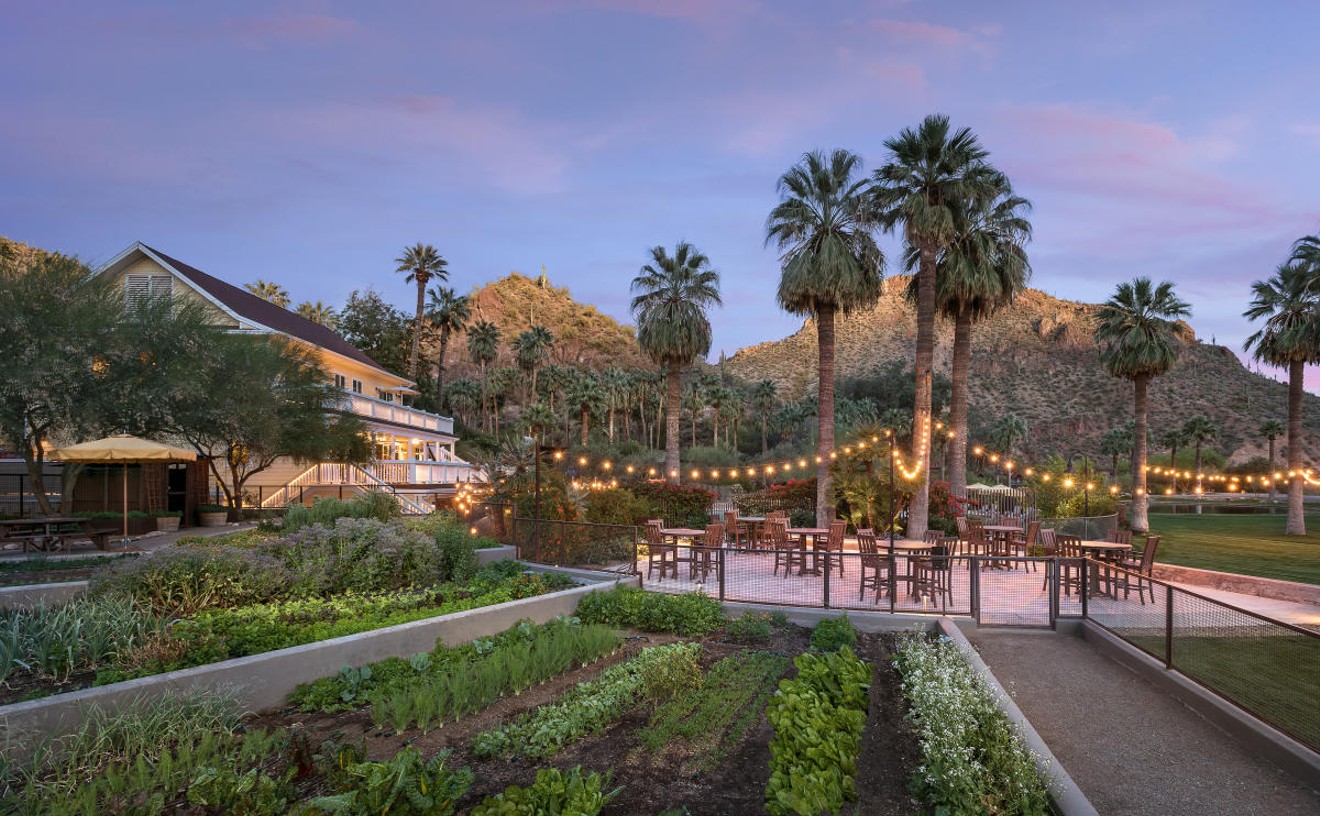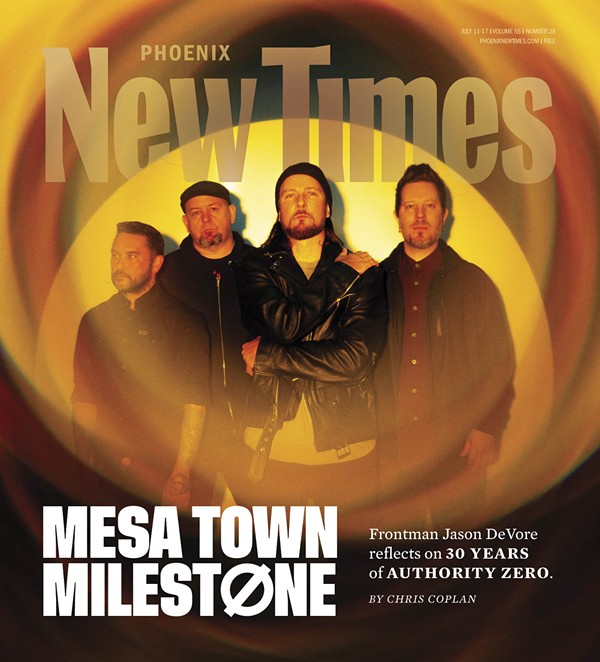The roster of Eye Lounge members includes many of Arizona’s most accomplished and best-known artists, who work in an impressive array of mediums including installation art, painting, photography, ceramics, video, and more. Nearly 150 artists have been members of the collective.
Recently, more than two dozen artists who’ve participated in the group spoke with Phoenix New Times about their experiences, including how the gallery affected their art practice, how Eye Lounge has shaped the downtown arts scene, and its ongoing role in the community.
Greg Esser and Cindy Dach officially founded Eye Lounge in 2000. The fellow artists and married couple own the building at 419 E. Roosevelt that has housed Eye Lounge for much of its existence. But the collective actually began without a building in 1999, which is where this story starts.
Greg Esser: Eye Lounge as a collective began long before there was a gallery. A large group of ASU MFA students and other artists got together responding to the lack of opportunities to exhibit unusual, experimental work. At that time, opportunities to exhibit were at Phoenix Art Museum and the Scottsdale galleries. The museum’s idea of an emerging artist was someone in their 50s or 60s, and the galleries were very limited in what they were showing. We worked to find places to exhibit our work.
The core idea is that artists can get together and do something in a collective way. We intentionally used the word “collective” rather than “cooperative” because it’s more forward-thinking.
We started the process of buying the building from Tom and Laurie Carmody in 1999 and closed on the sale in 2000. It was higher than we could afford at the time, but it meant the opportunity to control the future of the collective. Eye Lounge has served as an anchor in the evolution of the arts district, and worked with others to be a catalyst for First Friday.
Jen Urso: I remember a bunch of artists getting together and doing a word exercise game where we used a folded piece of paper and we all put down one noun and one verb. Then we unfolded the paper to look at the various phrases they made. There were some pretty weird ones. We all voted, and Eye Lounge was the clear winner.
Esser: The Eye Lounge logo painted on the building was designed by an artist out of Portland named Mike Kippenhan. He used an image of Michael Scott Speicher, the first U.S. casualty in the Iraq War, which came from a New York Times cover story published on December 7, 1997.
Carolyn Lavender: It was amazing when Greg and Cindy bought the building. Greg imposed a lot of the structure, like term limits, having a board, and potential members being presented by current ones. He had a soft-spoken leadership style that really worked. For the first year, Greg ran it, and I was the first president after that. Leading artists is never an easy thing. The collective experience isn’t for everybody. Some of the best artists are the worst at it.
Cyd Peroni: Everybody has a different role, such as doing the website, handling gallery maintenance, or looking for outside opportunities.
Danielle Wood: The three-year term is a little like grad school. You spend the first year getting a feel for what the collective is and how it works, then you take what you learned during your first year and grow so much. By the third year, you're really confident and making work that shows the cumulative effect of all your experiences there.
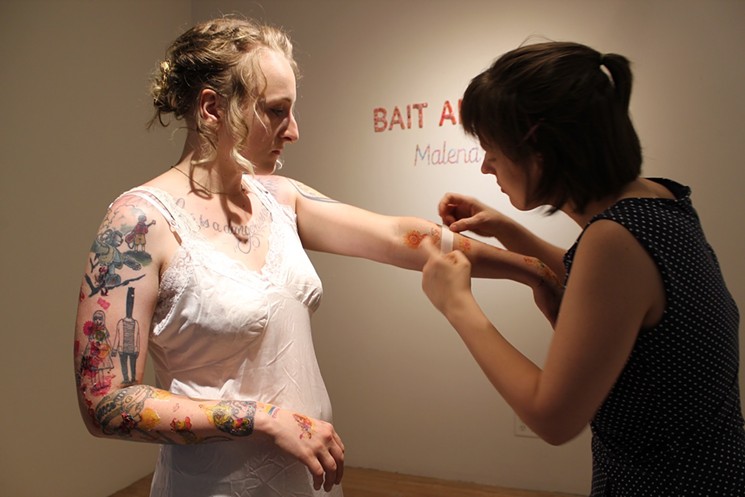
Malena Barnhart (right) and Kristen Schneider doing a durational performance at Eye Lounge in June 2017.
Michelle Sasonov
Logan Bellew: I really liked the way Eye Lounge did the shows, where artists brought their ideas to the monthly meetings and did a critique-like process with feedback from the other members. I learned how to explore how my work would be seen in a particular space.
Kate Timmerman: I was the project manager for the first Eye Lounge catalog, and I thought it was really important to document the space. Now, there’s a catalog for the 20th anniversary show. Artists that came after us added their twists in wonderful ways. I have high hopes, because the people who are there in the new space are bringing so much professionalism.
Urso: When the gallery first opened, we used to sit in the space on Saturdays and nobody came around. We used to get really excited when someone who wasn’t a friend came by on a Friday night. Everything was so spread out back then, and there wasn’t much foot traffic in the area. In the beginning, the gallery got tagged a lot.
Denise Yaghmourian: I remember hanging out in front of that building and having conversations with people who would show up. Roosevelt Row was a little bit more peaceful in those days, before all the outdoor stuff started to happen.
Monica Aissa Martinez: Phoenix was more transitory then, and we were all from different areas. Greg was already setting ideas of diversity back then. I met important people with great minds at Eye Lounge who changed the way I moved in the Phoenix arts community. It gave me a sense that there was a community out there and I could be part of it.
Bob Allen: There was a lot of construction across the street when I joined Eye Lounge. The original places like Eye Lounge were being dwarfed and it felt like being under siege. But it was still an important bridge for me. I met a lot of artists I wasn’t familiar with yet, and I learned a lot about promoting artwork on social media.
David L. Bradley: Eye Lounge was set in such a prime location, and it got great First Friday foot traffic. It was this lab for local artists, and you didn’t have to deal with curators. It’s getting harder and harder to find art spaces where you have that freedom. I’ve seen a lot of the artists who were members continue to stretch themselves. Eye Lounge is still fulfilling a powerful role in the cultural community.
Sean Deckert: Eye Lounge had a reputation as a clean, nice gallery without having a gateway vibe or a gritty DIY vibe. Without Eye Lounge, the downtown arts scene would have been less polished. Most artists in town have shown there, and we still need that.

The intersection of Roosevelt and Fifth streets before Eye Lounge relocated to the south side of MADE.
Lynn Trimble
Esser: The first Eye Lounge show was in the historical house where MADE and Eye Lounge are now. Then we renovated the historical storefronts built in 1949 and 1950, and there was a decline in membership because artists began to have more opportunities. We went to using half of that space, and half the number of artists. About five years ago, we divided the building into two spaces, and Ben’s Bells was in one of those spaces. The whole building is about 2,000 square feet. The two halves were about 750 square feet each (which is about the size of the current gallery), and there was also a smaller space called the Project Room.
Cherie Buck-Hutchison: I applied thinking there were 22 members and the whole original space. When I got the call that I was voted in, I learned there would be 11 members and a smaller space — but it worked out fine. It was easier to manage the smaller space, but there were fewer people to do all the jobs. I remember helping to powerwash the building. Now we’re all in this state of flux and holding pattern until we see what art spaces are going to end up looking like post-pandemic.
Constance McBride: I was one of the last members to have the experience of the entire larger footprint. I loved the Project Room because you could show things that weren’t finished yet. Sometimes we rented out the Project Room, so people got to see work by artists who weren’t members.
Dain Gore: When Eye Lounge built the stage, it gave me a place to do puppet shows instead of just showing my paintings. That’s still a big part of what I do, and the space really helped me develop my performing confidence. I started to realize that the puppet shows were really a viable thing.
Charles Kurre: The space was under renovation when I first got involved. There was some reconfiguring of exhibit schedules, but it wasn’t insurmountable. I find the current space very charming, warm, inviting, and intimate. There’s nothing more constant than change. I find it exhilarating.
Kim Sweet: I finished my last show when COVID-19 broke, so that was a huge gear shift. People had to make appointments to see the exhibit, or they could view it online. Even though my work was being seen differently, I got a good response. Eye Lounge gave me the confidence that my work really did resonate.
The collective has exhibited work in several additional spaces, including Mesa Contemporary Arts Museum and Vision Gallery in Chandler.
Urso: Early on, we did group shows at the old Mesa Contemporary Arts location and the Icehouse.
Esser: Eye Lounge briefly had space in the Alta (Skyline) Lofts a few years ago. We’ve also done satellite spaces and I expect that will continue. We did a show at Shemer Art Center recently, and our 20th anniversary show is at ASU Grant Street Studios.
The collective has earned a reputation for showing experimental works.
Lara Plecas: It was an opportunity to make and exhibit work in any way you could envision. You could think outside the box and push yourself in new ways. I took risks and learned to tell a story in my work — and I learned how to create a body of work. It’s really given artists a platform to hone their own voice.
Sarah Hurwitz: I came into my own at Eye Lounge, and it really changed how I make art. I’ve grown my installation art from being at Eye Lounge. Without it, I would have just been making paintings because it’s easier.
Barnhart: I always wanted to do more collaborative work, and Eye Lounge helped me to do that. They also gave me the ability to fail. I really appreciate the lack of censorship and all the weird things I’ve seen there. Members came with different perspectives, at different stages of their careers, and it was very equalizing.
Yaghmourian: I did a show in the Project Room before I was a member, and I was playing around with the cube. It was the first time I did a fabric piece with hooks and eyes. One of my red cubes ended up on the cover of Phoenix New Times. That never would have happened if I hadn’t shown at Eye Lounge. I think Eye Lounge has been successful because it’s continued to be a space where artists can experiment.
Kristin Bauer: Eye Lounge had a big impact on my art practice. It was the first time I showed text-based work. Eye Lounge was a gateway to the arts community, and I know a lot of people who would have left Phoenix sooner if they hadn’t been involved there. We were all learning together, and I’m still friends with so many of the Eye Lounge artists.
Martinez: It was a cool thing to play out an idea for 12 months. I started really focusing on the body at that point in time, and I got bigger with my work.
Daniel Funkhouser: I saw people that I admired having exhibits there. I almost didn’t apply because I thought I wasn’t good enough. For your first show, no one knows who you are. By your third show, people come back to specifically see your work. Thousands of people would come through, which was more eyeballs than had ever looked at my work before. I learned a lot of my professional skill set at Eye Lounge, and I learned how to talk to people in the art world.
Mary Meyer: Joining Eye Lounge was one of the best decisions of my career. I hadn’t had that kind of community since grad school. I got gallery representation based on my solo show at Eye Lounge.
Bellew: Eye Lounge gave me the courage to experiment with installation work, which has been instrumental to my art practice. When I was president we had an internship program; the first intern was Mikey Foster Estes. The work I did at Eye Lounge helped me get into grad school, and build momentum in my career.
Chris Jagmin: I learned how to put on a show at Eye Lounge, but the experience also taught me not to do some things: Don’t not do the work, and don’t assume that people will just show up because it’s Eye Lounge. Looking back, I wish the collective had included more artists of color, and more ways for donors to support under-served artists.
McBride: Without Eye Lounge, I wouldn’t have been exposed to as many artists. Everyone had different methods and processes and styles. It pushed me to experiment more, and try different materials. I learned what I could get away with as an artist.
Turner G. Davis: There was a constant flow of new people coming through Eye Lounge, and you never knew who would walk in. You could just be a fly on the wall and people wouldn’t even know you were the artist. It was a very democratizing way of getting a sense of how people related to your work. The artists came from different disciplines such as sculpture and photography, and there was this incredible cross-pollination. It was really fertile ground, and I got to collaborate with so many people. I feel like Eye Lounge was a real place of connection. It really changed my life.
Hurwitz: I met literally the entire arts community through Eye Lounge. I’m not a very social person, but it was a great place to meet people and talk through ideas. Eye Lounge was a hub. It added credibility without being snooty.
Timmerman: The founding mothers and fathers of Eye Lounge created an incredible sense of community, and the sense that members were always passing the baton. They created something really precious for the arts community because they thought about the whole community instead of just putting on their own shows.
Elizabeth Odiorne: I’ve gotten great feedback whenever I’ve wanted it and needed it. As an up-and-coming artist, it can be intimidating to step into the downtown Phoenix arts scene. It’s great to be in such great company and feel like you really share a bond with other artists.
William LeGoullon: The best part of being in the collective wasn’t necessarily having exhibits. For me, it was the relationships I formed with artists and arts professionals
These days, artists are thinking about how Eye Lounge might evolve moving forward.
Plecas: It’s a different city than it was when Eye Lounge began. The arts have been edged out and it’s really been gentrified. There was a lot of magic, but the area will never be like it was before. It’s been beautiful to see everyone growing and doing their own thing. Eye Lounge has had a beautiful 20-year run. Greg and Cindy will know when it’s run its course.
LeGoullon: I could see it changing location or format; maybe it’s not just a brick-and-mortar gallery. In its purest form, Eye Lounge has always been a collective, so regardless of any new identity it takes on, the core will remain.
Sweet: I hope people know what a unique thing we have. The space has changed because the neighborhood has changed, but the space is less important than the tone. I just want to be protective of it; Eye Lounge is a little gem.
Esser: I don’t have a crystal ball. I don’t know if Eye Lounge will be in the same building or live on in the people who’ve been a part of it. The collective started without a physical space, and the group is an intentionally constantly changing thing. We’re not confined to physical spaces. At the end of the day, I’m most proud of the people who have been part of this. We’ve demonstrated that artists working together can do something that’s greater than the sum of its parts.
"20/20: 20 Years of Eye Lounge" runs from October 15 to 24 inside Step Gallery and Northlight Gallery at ASU Grant Street Studios, located at 605 East Grant Street. Reservations are required for the opening reception happening from 6 to 9 p.m. on October 16. Masks and social distancing are required for all gallery visitors.








